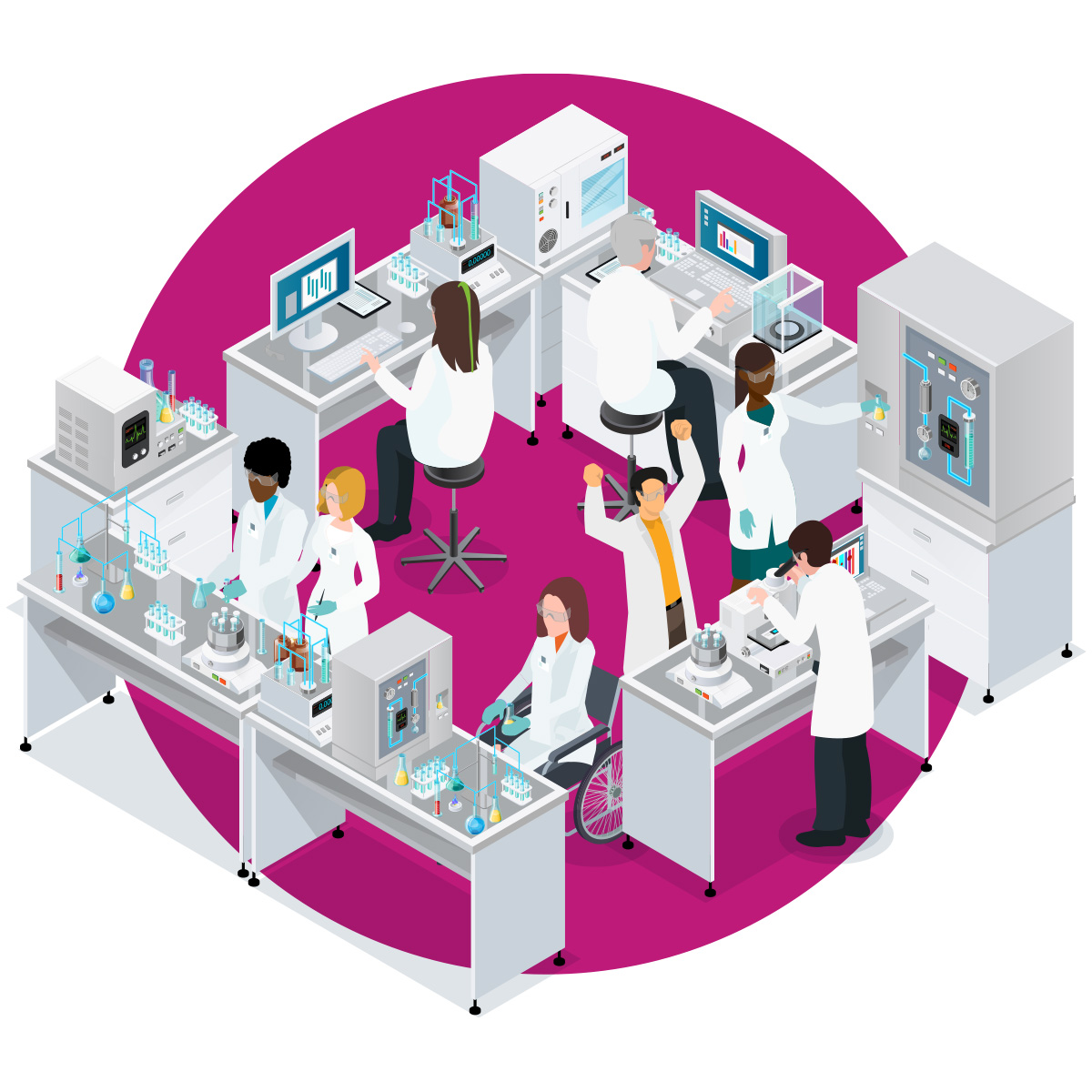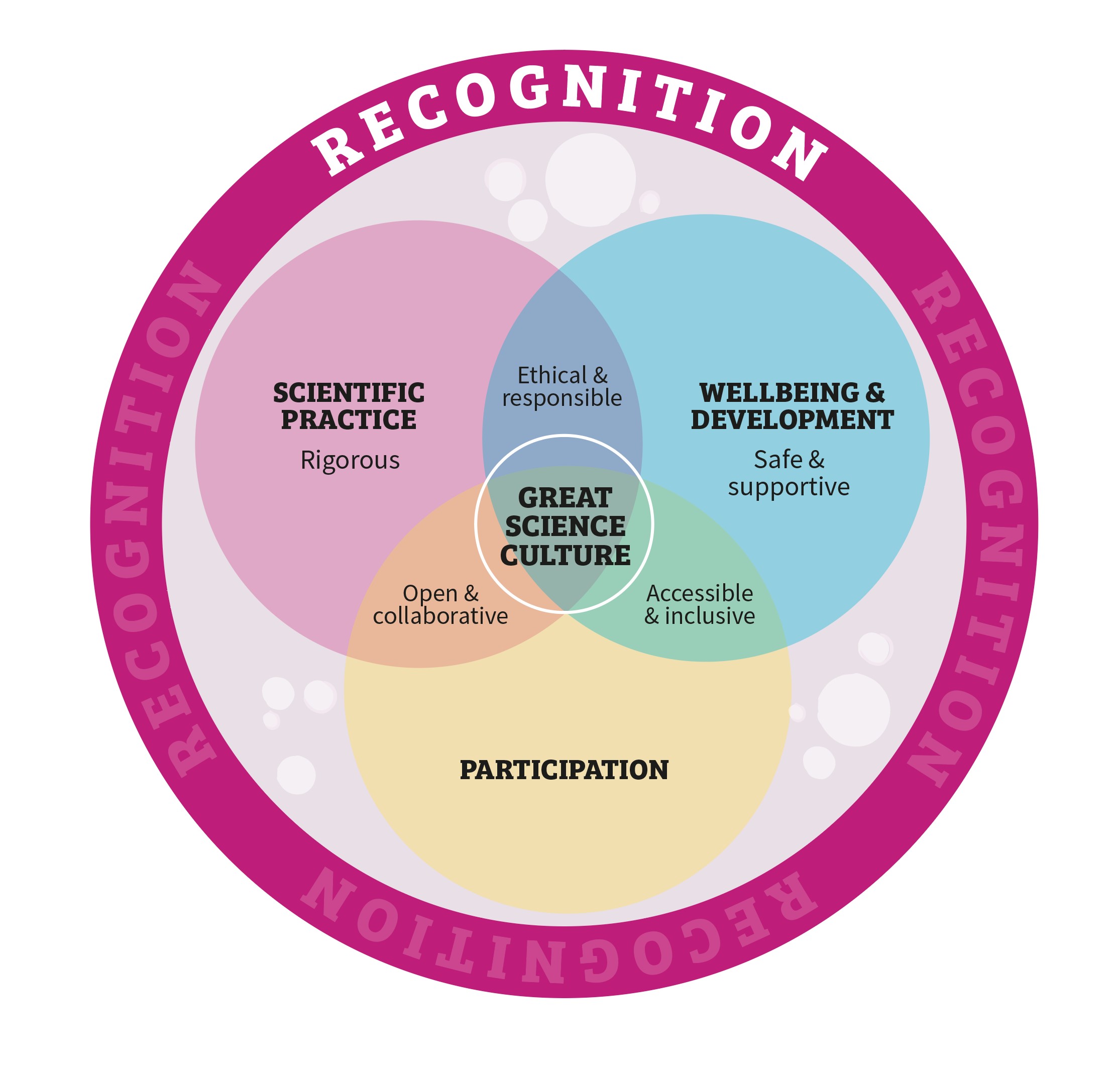Science culture encompasses the behaviours, values, expectations, attitudes and norms of science communities. It influences career paths and affects the way that science, innovation and associated services are designed and delivered. It is defined by the conduct, practices and approaches of individuals, groups and organisations and the extent to which they are empowered to do what is best for science and for society.
This definition is developed from the Royal Society's definition of research culture.
Taboos and tricky topics: a discussion series
Now that we have set out our vision, the next step is to create spaces for challenging conversations where everyone has the opportunity to discuss the various barriers and tensions that can hamper the pursuit of a great science culture.
We’ve identified five key areas for discussion, and throughout the first half of 2024 we will be holding a series of interactive, facilitated, online panel discussions on each of these topics.
Jump to:
Working towards a great science culture
What does this look like for the chemical sciences and how can we achieve this?
We envision a science culture that supports an open, inclusive and enabling community for the benefit of everyone. We believe that this is fundamental for science to make its maximum contribution to global prosperity.
We have developed a vision for a great science culture as a key step in fostering this environment. It presents the behaviours and attitudes we value in science and sets out a common direction that everybody can take action on. It builds on our existing activities as well as input from our community.
Achieving the vision will require a collective effort, will not be without challenges and will take time. We are committed to playing an active role in helping the chemical sciences community realise its potential to improve science culture and make the world a better place.
A positive culture is essential to create an enabling community and support quality science.
It includes themes such as inclusion and diversity, ethical practice, open science, and recognition of science and scientists. We, alongside other organisations, have been driving change in these areas through our:
- Belonging in the chemical sciences study
- extensive inclusion and diversity work
- professional and career support
- commitment to open science
- Rethinking Recognition efforts to modernise our prize portfolio
The chemistry community has worked closely with us to deliver these activities, demonstrating a shared willingness to contribute to change. However, the research underpinning some of this work has also exposed barriers, some of which are hard to address without considering science culture holistically.
Articulating what a positive science culture looks like in our discipline sets a common direction for improvement, a framework to discuss and address barriers and tensions, and helps each of us identify how we can contribute.
Our vision for a great science culture
Our vision describes the key qualities and foundations that are required for a great science culture, as well as the underpinning role of recognition in incentivising individuals, teams and organisations to contribute to an enabling community and quality science.
A great science culture comprises good scientific practice, support for wellbeing and development, and maximum participation in science and innovation.

The qualities of a positive science culture must be embedded throughout science education and practice, although how this is achieved in practice will vary according to context. Leaders and managers at all levels must understand the need for change and play an active role in enabling it.
Both regulatory and voluntary approaches are needed to remove unnecessary barriers to entry, support sustainable science and innovation careers and reinforce high standards of professional conduct. There must also be clear routes for holding individuals and organisations accountable, including funders, employers, scientists, innovators, and service providers.
Why a positive science culture is important
It is fundamental for research and innovation, scientific excellence and job satisfaction. It enables scientists and innovators to reach their full potential and creates space for discovery, creativity and innovation. It results in an attractive work environment where individuals feel valued and empowered. Ultimately, it maximises the quality of science and innovation and its benefit to society.
The foundations and qualities of a great science culture
There are five key qualities that apply across the three foundations of a healthy scientific environment. These are underpinned by a recognition system that incentivises diverse careers and contributions, including nurturing a positive culture. Some of these qualities overlap across the foundations:

Five qualities of a positive science culture
The three foundations of a great science culture
The qualities described above are evident across three foundations of a great science culture.
1. Scientific practice
This covers the way science is carried out. Good scientific practice is achieved when science and innovation are conducted in a rigorous, ethical and responsible way. Effective science is also open and collaborative, involving the sharing of knowledge and expertise across disciplines, sectors and countries.
2. Participation in science
This encompasses who is able and enabled to take part in science and innovation. Broad participation requires an inclusive and accessible environment that ensures no one is barred from contributing. And, an open and collaborative approach that brings together the right knowledge and the right people to maximise the quality and impact of science and innovation.
3. Wellbeing and development
This is about the way people are treated and how they are empowered to achieve their potential. Workplaces that safeguard wellbeing and encourage development are inclusive and accessible, as well as safe and supportive. They also require adherence to ethical and responsible conduct to ensure that no harm is caused to anyone involved.
See how the qualities overlap across these foundations.
The role of reward and recognition in creating a positive science culture
Recognition plays a critical role by incentivising behaviours that align with and foster a positive science culture.
Our vision is that the wide variety of contributions and impact that scientists and innovators make to quality science are recognised by funders, employers, colleagues and other organisations by giving them reward and recognition.

This requires appropriate criteria, tools and processes for recognising:
- The various contributions scientists make to achieving the key qualities of a positive science culture
- The diverse range of practices and activities that scientists and innovators engage in across research, research management, teaching, leadership, service and commercialisation, as well as the outputs, outcomes and impacts that they achieve
- The various roles that scientists and innovators take on, including leadership, management and supervision roles
- Collective contributions, in addition to individual ones, including teamwork and interdisciplinary, intersectoral and international collaboration
- All contributors to science and innovation irrespective of their job title or seniority
As a result, individuals can focus on a manageable selection of contributions, and a wide range of careers are supported, valued, rewarded and recognised by funders and employers.
Overcoming barriers to achieving our vision

We held a series of engagement activities and focus groups with �������ϲʿ�����¼ community groups and wider stakeholders to gather views on our vision for a positive science culture in the chemical sciences and priorities for change.
Key themes from our community engagement
While our community identified progress in some areas, in particular on inclusion and diversity, they highlighted a range of barriers to address – and tensions to work through – to achieve the vision we have set out. This feedback will inform our ongoing work to support the community in its efforts towards improving science culture.
Key issues raised include:
- A lack of diversity at the point of entry to the STEM talent pool is holding back progress in increasing diversity of the workforce at later career stages
- It remains challenging, especially in academia, to balance a career with caring responsibilities due to a lack of job-share and part-time working models, and a recognition system focused on the individual over the collective
- Good practice is not always rewarded, and practice that does get rewarded is not always good practice. This disconnect, alongside a lack of consistent (mandatory) training, is a key barrier to achieving rigorous, open, ethical and responsible science and innovation
- Creating a no-blame environment where mistakes can be made, and questions can be asked openly, is challenging. Several participants highlighted a lack of safety to have these kind of conversations
- Leaders and managers are expected to play a significant role in improving science culture, but their responsibilities might not always be clear, and they don’t always have the support to develop the required skills. In addition, neither management contributions nor contributions to improving culture are well recognised
Read our Community feedback on science culture for a more detailed summary of the views shared by members of the chemical science community.
Initial actions responding to community needs
Our vision for a positive science culture sets the direction for our long-term plan to help our community on its journey to improve science culture.
We will continue to develop initiatives to support this aim over the long term.
Our commitments
In response to the needs expressed by our community, we will also:
Increase our efforts to share practical resources to support our community in overcoming barriers to improving the culture of the chemical sciences
Create space for brave conversations covering areas where our community has identified tensions between the qualities of a positive science culture
Showcase good practice examples of leadership, highlighting where leaders go above and beyond to break down barriers and open up opportunities
These steps are in addition to the extensive work we are already doing on inclusion and diversity, ethical practice, open science, and recognition of science and scientists.







